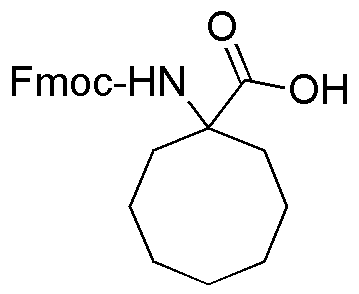Fmoc-1-amino-1-cyclooctanecarboxylic acid is widely utilized in research focused on:
- Peptide Synthesis: This compound serves as a protecting group for amino acids in solid-phase peptide synthesis, enhancing the efficiency and selectivity of the process.
- Drug Development: Its unique structure allows for the design of cyclic peptides, which can lead to more stable and effective drug candidates in pharmaceutical research.
- Bioconjugation: The compound can be used to create bioconjugates, facilitating the attachment of biomolecules to surfaces or other molecules, which is essential in diagnostics and therapeutics.
- Material Science: It plays a role in the development of new materials, particularly in creating polymers with specific properties for applications in coatings and adhesives.
- Research in Neuroscience: The compound's structure is beneficial in studying receptor interactions, aiding in the understanding of neurological pathways and potential treatments for neurological disorders.
General Information
Properties
Safety and Regulations
Applications
Fmoc-1-amino-1-cyclooctanecarboxylic acid is widely utilized in research focused on:
- Peptide Synthesis: This compound serves as a protecting group for amino acids in solid-phase peptide synthesis, enhancing the efficiency and selectivity of the process.
- Drug Development: Its unique structure allows for the design of cyclic peptides, which can lead to more stable and effective drug candidates in pharmaceutical research.
- Bioconjugation: The compound can be used to create bioconjugates, facilitating the attachment of biomolecules to surfaces or other molecules, which is essential in diagnostics and therapeutics.
- Material Science: It plays a role in the development of new materials, particularly in creating polymers with specific properties for applications in coatings and adhesives.
- Research in Neuroscience: The compound's structure is beneficial in studying receptor interactions, aiding in the understanding of neurological pathways and potential treatments for neurological disorders.
Documents
Safety Data Sheets (SDS)
The SDS provides comprehensive safety information on handling, storage, and disposal of the product.
Product Specification (PS)
The PS provides a comprehensive breakdown of the product’s properties, including chemical composition, physical state, purity, and storage requirements. It also details acceptable quality ranges and the product's intended applications.
Certificates of Analysis (COA)
Search for Certificates of Analysis (COA) by entering the products Lot Number. Lot and Batch Numbers can be found on a product’s label following the words ‘Lot’ or ‘Batch’.
*Catalog Number
*Lot Number
Certificates Of Origin (COO)
This COO confirms the country where the product was manufactured, and also details the materials and components used in it and whether it is derived from natural, synthetic, or other specific sources. This certificate may be required for customs, trade, and regulatory compliance.
*Catalog Number
*Lot Number
Safety Data Sheets (SDS)
The SDS provides comprehensive safety information on handling, storage, and disposal of the product.
DownloadProduct Specification (PS)
The PS provides a comprehensive breakdown of the product’s properties, including chemical composition, physical state, purity, and storage requirements. It also details acceptable quality ranges and the product's intended applications.
DownloadCertificates of Analysis (COA)
Search for Certificates of Analysis (COA) by entering the products Lot Number. Lot and Batch Numbers can be found on a product’s label following the words ‘Lot’ or ‘Batch’.
*Catalog Number
*Lot Number
Certificates Of Origin (COO)
This COO confirms the country where the product was manufactured, and also details the materials and components used in it and whether it is derived from natural, synthetic, or other specific sources. This certificate may be required for customs, trade, and regulatory compliance.


